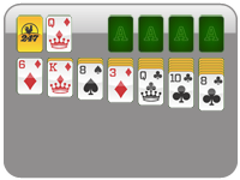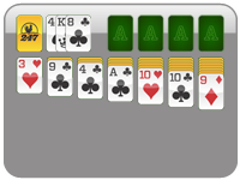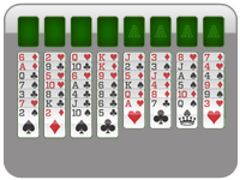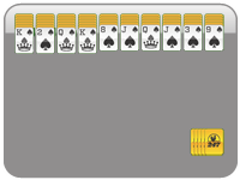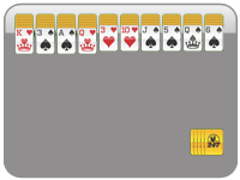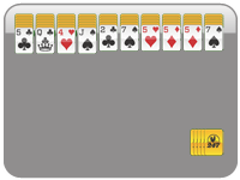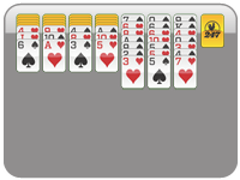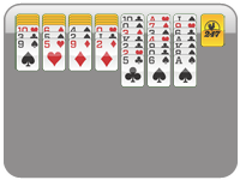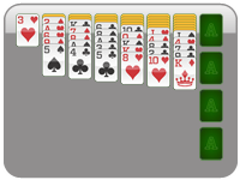Solitaire Rules for Beginners: How to Get Started

Solitaire can be an intimidating game to approach. That’s why we’ve taken the liberty of creating this guide to help get you up to speed on all the rules, so you can start playing your own games of Solitaire in no time.
What are the basic rules of Solitaire?
Playing a standard game of Solitaire, or Klondike Solitaire as it’s called, is a combination of organization and memory. Players must take a vast, multi-stack array of randomly assorted cards and sort them into an organized set of foundations by each respective suit: hearts, clubs, spades, and diamonds.
Understanding all the rules of classic Solitaire

As a single-player game, the pace of Solitaire is largely up to you. Solitaire has a relatively simple setup using only a single deck of 52 playing cards. Your main opponent is the randomness of the shuffled deck and being able to finish a game.
We’re going to break down the rules of Solitaire as simply as we can to better understand them all and make them easier to follow. We’ll cover the initial deal, the purpose of each card, card movement, and more. Let’s get started.
Solitaire rules: Dealing
Interacting with the tableau will be your primary sequence of gameplay. So what is it? The tableau is the main game space in which Solitaire games take place. The player strategically picks through lanes of randomly assorted cards and arranges them while abiding by certain restrictions.
In Klondike Solitaire a tableau consists of seven stacks comprised of 28 cards from the deck. Create your tableau by building these seven stacks from left to right, each increasing in size starting with a single face-up card on the left up to six cards face down and one up on the right.
The stacks may require a great deal of table space. Plus, you’ll need even more for Solitaire’s stock, waste piles, and foundations. We’ll get into those shortly. (Hint: to skip the lengthy setup of Solitaire, you can play online at 247Solitaire.com.)
Solitaire rules: Cards and suits
Remember the tableau is set up with many of its cards face-down. These cards are “hidden" and must be revealed to move them and progress the game. A card is revealed when it becomes the topmost card of that stack. For larger tableau columns, you’ll have to move cards around to reveal the hidden cards underneath.
Columns are created by arranging cards in numerical order and alternating black and red suits. Here is a quick reminder of the proper numerical order for cards: Ace>2>3>4>5>6>7>8>9>10>J>Q>K!
Solitaire rules: Stock and Waste
Cards not used to create the tableau become your stockpile. This stockpile is drawn from throughout the game to add single or multiple cards to the tableau. Next to the stockpile is the wastepile. This is where stockpile cards that cannot be initially played into your tableau are placed. All drawn stockpile cards should be kept in the order they were drawn. When the stockpile runs out, simply flip the wastepile and redraw.
There are two ways to play with the stockpile in Klondike Solitaire: a three-card or single-card draw. If you’re just getting started in the game and want to begin a bit easier, we recommend the single-card draw.
Solitaire rules: Moving cards
From drawing stockpile cards to arranging them in your tableau, you can’t simply move each card with free reign. The difficulty of Klondike Solitaire comes from the restrictions placed upon card movement. It’s important to know the rules and restrictions to play intelligently.
The most immediate restriction is that you can only move a card if it has no cards in front of it. Hidden cards or cards farther back in a tableau column cannot be moved before the more immediate cards in the column are out of the way. You can move multiple cards at the same time, but only as a single unit, and if none of the cards are hidden.
Importantly, you must alternate the color of cards stacked in your tableau columns. You may also only play cards if they are in the correct numerical order. For example, you can only play a red 4 card on top of a black 5 in your tableau. You then repeat this pattern onward.
Solitaire rules: Empty spaces
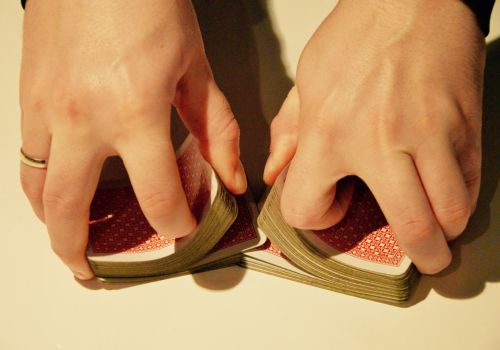
During a game, you might notice you’ve created an empty column space in your tableau. These empty spaces can be incredibly impactful on the game and help alleviate any difficulty in arranging cards in your tableau. An empty space is used to start an entirely new tableau column, but only if you have a king card to start the sequence.
Solitaire rules: Filling foundations
If you have any aces show up during your game, these can be moved to the foundations. Filling the foundations is the final goal of the game. There are four spaces for each of the four individual suits. You must transfer every card in the game to the foundations to officially “win". Remember that aces are low in Klondike Solitaire, and foundations are built from aces up.
Since each foundation pile is designated for an individual suit, it can be strategic to build them evenly instead of solely focusing on one. Running out of red or black cards is a quick way to find yourself in an unwinnable game.
Try playing Solitaire for free and put your knowledge to the test
If you’d like to put this new Solitaire knowledge to the test, check out some of 247 Solitaire’s wide collection of Solitaire games. 247 Solitaire is your one-stop destination for all things Solitaire with guides, extra modes, special features, and more. Happy playing!
Solitaire Games
More Solitaire Games
More Games
Solitaire News
Disclaimer
DISCLAIMER: The games on this website are using PLAY (fake) money. No payouts will be awarded, there are no "winnings", as all games represented by 247 Games LLC are free to play. Play strictly for fun.

